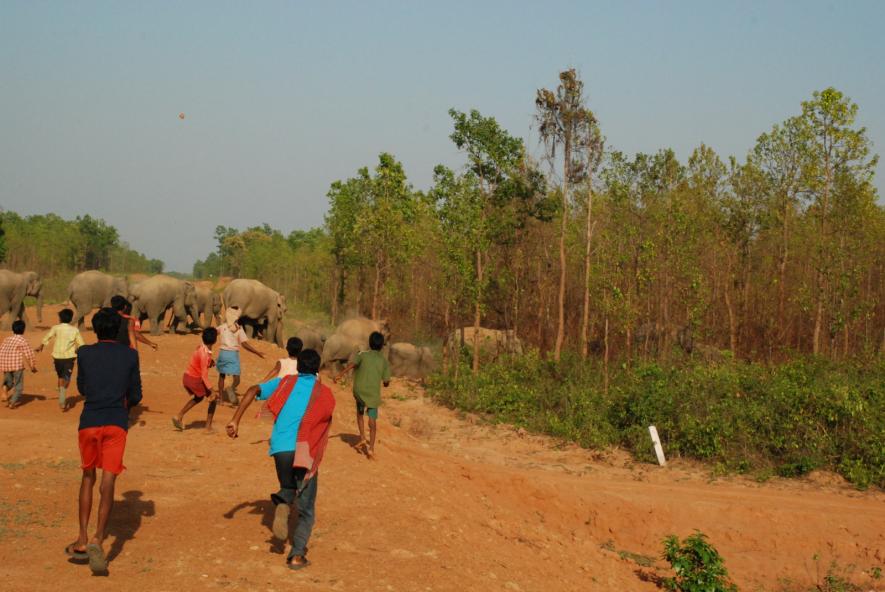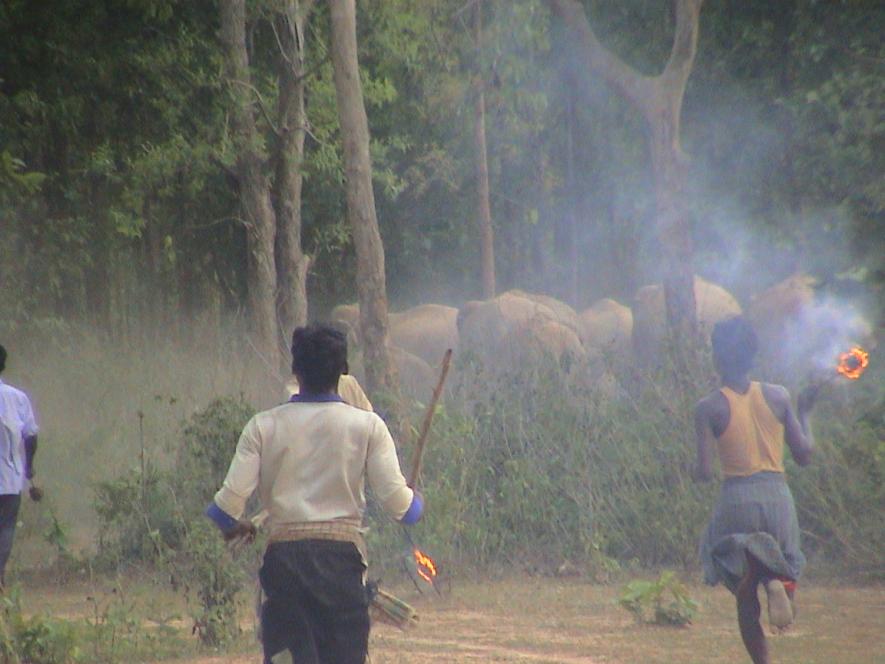GROUND REPORT: Elephant Attacks Cast Shadow of Fear Over 4 Bengal Districts

In the evening and midnight of January 10, 2023, two persons, including a middle-aged woman, were killed in separate wild elephant attacks at Barjora forest range area in the district Bankura, West Bengal.
Next afternoon, S Kunnaldivel, the chief conservator of forest (CCF) central circle, held a meeting with Vaibhav Tiwari, Superintendent of Police, Bankura, District Forest Officer, North and other senior civil, forest and police officials at the Beliatore forest bungalow, to discuss ways and means to tackle incidents of attacks by wild elephants.
Five days after this high-level discussion, another person at Sagrakata, Brindabonpur gram panchayat of Barjora block, lost his life following a tusker attack.

The incidents did not end there. Some members of a hula party (scaring team), who risked their lives to work in the forest to drive away wild elephants, were killed by a wild elephant in the Ropot forest area of Sonamukhi on January 30, 2023.
In fact, this ‘death march’ following wild elephant attacks, has been going on in Bankura, West Midnapur, Jhargram and Purulia.
As per a Right to Information reply by the government, in West Bengal, 643 people had died in wild elephant attacks from 2014-2022, followed by Jharkhand (640). According to the information provided by the forest department, in the past 10 years, 114 people have died in Bankura district due to such attacks.
“People of Barjora, Sonamukhi, Beliatore are living in terror. Right now, especially people of villages adjoining the forest area of these three police station zones, are living on the brink of life and death”, Sankar Maji, a former member of the Bankura Zilla Parishad and inhabitant of Jhoria village, where an elderly woman, Tulsi Batobyal, was killed by a wild elephant on January 10, 2023, told this reporter.
Mitton Mohonto, a resident of Kochdihi village, told this reporter that: “People stay virtually locked in their houses, as wild elephants have been regularly attacking houses and crops. Not only that, day after day people have been dying due to wild elephant attacks.”
He said: “Earlier, elephants used to attack after dusk, now there is no specific time, herds can attack any time. It is not only a nightmare, but a great threat to our lives, we are bleeding mentally and physically,” he said.

Describing the elephant attack on her mother-in-law, Pratiman Batobyal, daughter-in-law of deceased Tulsi Batobyal, said: “At night we were all sleeping. My mother-in-law was sleeping in the mud house. When we heard tusker’s roar, she opened the door to see what was happening. That very moment, the tusker dragged her and killed her on the spot. Her whole body was bruised”.
The question is, why are wild elephants entering houses at midnight and killing people? Did that particular elephant become a rogue? This fear is spreading in villages.
The people of the area complained that the forest department and panchayat were not taking proper action despite such incidents, which are not only causing loss of lives but damaging crops, too.
Are such tusker attacks new in Bankura, Jhargram, West Midnapur, Purulia? No. In the early 1980s, wild elephant herds started coming from the Dalma Hills area of Jharkhand. The herds used to go around Midnapur, Purulia. After staying and roaming for a few days in these two districts, the herd entered the Bankadaha, Basudebpur forest of Bishnupur in Bankura.
During the 1970s, this area was almost deforested. Later, the forest grew through the social forestry initiative taken by the then Left Front government. Cultivation began in land that had been lying uncultivated for long in the jungle adjoining area.
“Elephant herds from Dalma started coming here due to accessibility of deep forest and natural foods,” a former ranger of Bishnupur told this reporter. He recalled that 1987 onward, in mid-August, elephants used to enter the Bankadaha area. Then they were 20- 30 in number. This number increased gradually, but never exceeded 40 elephants. He recalled that even then, crops and some houses were destroyed and some people had also died in tusker attacks.
After roaming in the Bishnupur forest area, the migrant elephants crossed Darakeswar river to reach Sonamukhi, Beliatore, Patrasayer and Barjora. The herd destroyed paddy fields while harvesting was going on in November, a forest officer told this writer. In this situation, several meetings were held with civil administration, the panchayat samiti, local people on how to deal and combat elephant attacks.

Following this, loudspeaker canvassing was conducted throughout the affected villages. People were warned about elephant herds. The three-tier panchayat had a big role to play. Dipankar Ghose, a resident of Saharjora told this writer, those days, the herds were carefully driven out by trained forest personnel and hula parties. As a result, the loss of human life, destruction of houses and crops had reduced. Not only that, when elephants roamed around, the forest department had provided search light, torches and winter clothing to the villagers concerned to control wild elephants.
Above all, the forest protection committees of the area used to monitor the movement of elephants. By January end, the herds used to leave Bankura, Midnapur, Jhargram, Purulia, and head toward Dolma. A few of them remained here, as they became residential, and very occasionally disturbed the village.
Since 2011, after the change of government in the state, such scenes are no longer visible. The present state government (ruled by the Trinamool Congress), has played no strong role in saving people’s lives, crops or homes from tuskar attacks, Sujit Chakroborty, former MLA ( member of legislative Assembly) from Barjora, told this reporter.
Now, almost 90 wild elephants are roaming around Barjora, Beliatore, Sonamukhi and Gangajolghati.
“There is no fixed time for elephants to come from Dalma. Massive deforestation, poaching and encroachment is going on in Dalma forest corridors, leaving no food for the elephant herds, which is the main cause for the attacks,” Sagar Badyakar, a former forest kormadyoksha of Bankura Zilla Parishad, told this reporter.
Another Bishnupur officer (not wanting to be named) wanted to know why the elephants could not be kept in the Dalma and Moyurbhanja projects, on which crores of rupees were being spent. At present, 300 wild elephants from Dalma are roaming in these four districts, Bankura district has 90 of them, he said, adding that they are destroying crops, houses indiscriminately.
Dayamoy Bauri, a land labourer in Sagrakata village of Barjora, said “we cannot cultivate our land for fear of such attacks.” As a result, farmers and farm labourers are suffering, as acre after acre of cultivated land lies vacant. “How can we run our livelihood?” Bauri asked this writer.
Rabi Maji, a marginal farmer, said: “Earlier, in case of crop damage, we received proper compensation, but now we have not received any compensation for two years. From dawn to dusk, we hear the roar of wild elephants, we don’t know who will die after being trampled,” he said.
Anima Lohar, a land labourer in Muktatore at Saharjora gram panchayat, said: “In the past 10 years, 13 people have been killed by wild elephants at this village, where most of the people are farm labourers. There is no work in the panchayat. We did not get MGNREGA (rural job guarantee scheme) work for the last two years. We used to collect tree branches from the nearby forest and sell those for a living, but now we cannot leave the house due to fear of elephant attacks. “How can we survive without work?” she asked this reporter.
In this situation, what is the role of the West Bengal forest department, as people of these four districts are spending days in fear? When asked, an additional district forest officer, north division of Bankura, said: “Our staff and hula parties are trying to prevent elephant attacks” But, people in the affected area were not willing to accept the official’s statement.
Ajit Lohar and Sujit Chakroborty, formar MLAs Sonamukhi and Barjora, respectively, said earlier driving away elephants was decided Centrally, now it is not. A meeting was held in 2019 at Beliatore Forest Bungalow in the presence of the forest minister of Bengal Rajib Banerjee. There it was decided that hula parties would be given scientific training to control elephants, but this did not happen.
“Cores of rupees are being spent annually in the name of the elephant drive, but none of those who are part of the hula parties have been trained. Actually, most of them are hired from outside. They do not know the area and the nature of the forest. For a daily wage of Rs 284, they work at great risk to their lives,” Lohar told this reporter.
“Gurudas Murmu, a hula party member, who came from Ranibandh, lost his life in the Ropot forest of Sonamukhi while chasing away wild elephants on January 30. A few days ago, five members of a hula party were seriously injured in this area.
An ADFO of the North division told this reporter that now the elephant herds of Dalma are staying in Saharjora jungle. Electric fencing has been done in that area, he said.
But the people of the area say the confined elephants are not being given the necessary food. Will a few cabbages and some potatoes fill an elephant’s stomach, they ask. People also complained that most of the time, without informing the villagers, the forest department releases elephants randomly. The herd then eats and destroys their grain due to hunger. When people try to drive them away, they attack violently.
Some villagers also said that electric wires lying along the cultivated land to protect those from elephants had resulted in several elephants dying due to electrocution in the past five years. “Why is the panchayat silent, as such incidents are happening day after day?” they ask.
A retired forest official told this reporter that the number of staff in the forest department has reduced drastically. “There is no new recruitment, a ranger has to look at two or three ranges,” he said, requesting anonymity. He further said that to combat the elephant attacks, several watch towers have been installed in the four districts at a huge cost. But there are no forest guards to monitor the movement of wild elephants.
It is even alleged that torches, oil and search lights which are required for chasing elephants, are not available from the forest department. People are not getting these instruments at the right time, he alleged.
As a result, when elephant attacks started in the area, all anger of the local people came down on the forest workers, because they were not available in the crisis period.
The forest protection committee, which was formed in the 90s with the people from the jungle area to protect the forest, is now on paper. “They have no role in reality,” Manoj Chakroborty, a farm labourer in Sonamukhi, said.
In the 1970s, Hindi superstar Rajesh Khanna’s film, Haathi Mere Sathi, had created an endearing image of man-animal relationship. However, in real life the story is very different. Forest dwelling elephants are as wild as tigers. And when there is disruption in their habitat, they can be violent. It is for the government and common people to think, why this is happening and how to co-exist peacefully.
The writer covers the Bankura region for Ganashakti newspaper in West Bengal.
Get the latest reports & analysis with people's perspective on Protests, movements & deep analytical videos, discussions of the current affairs in your Telegram app. Subscribe to NewsClick's Telegram channel & get Real-Time updates on stories, as they get published on our website.















